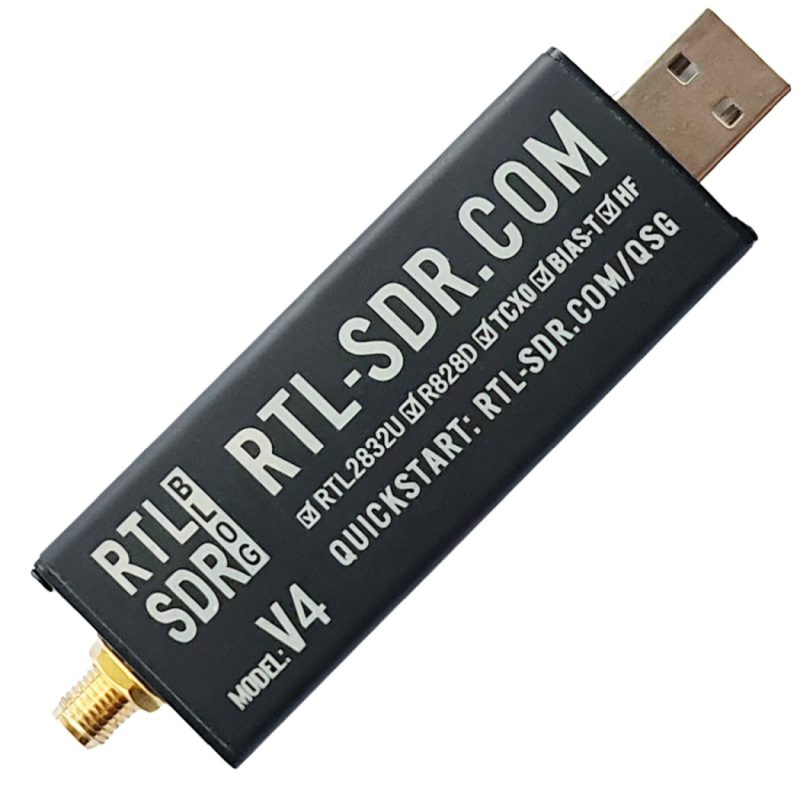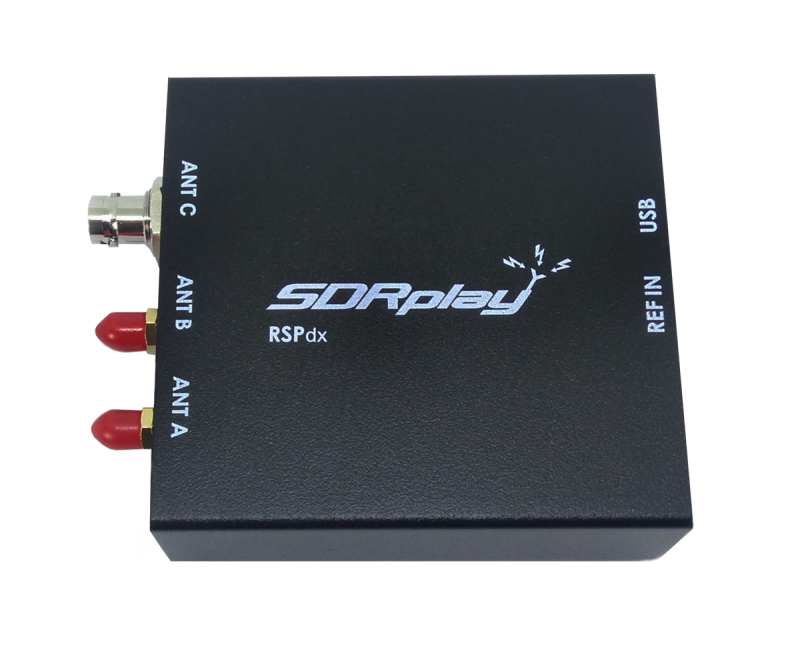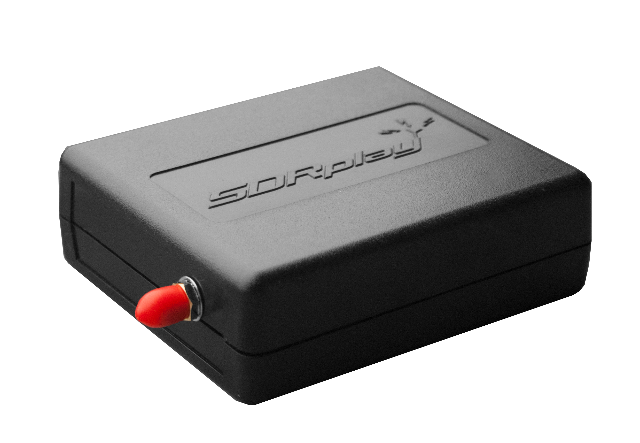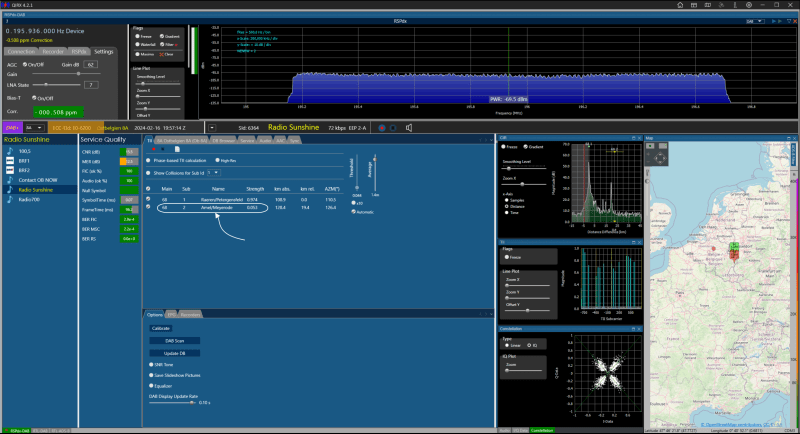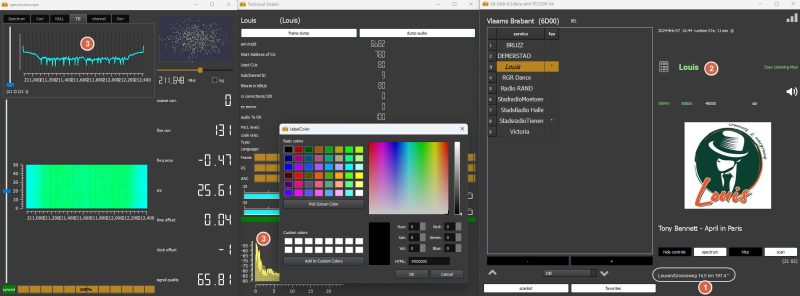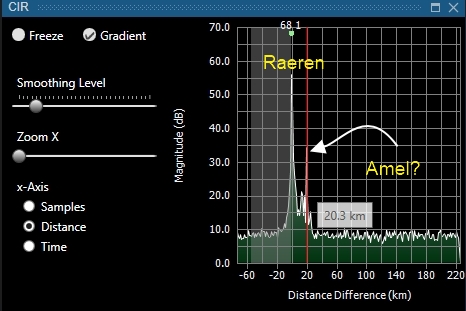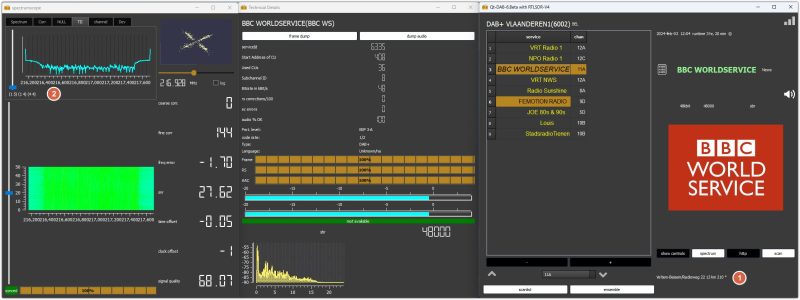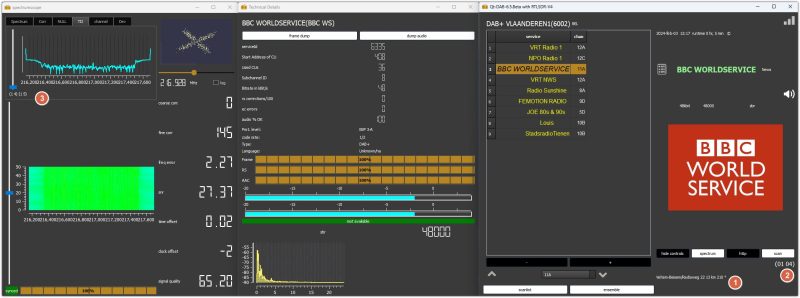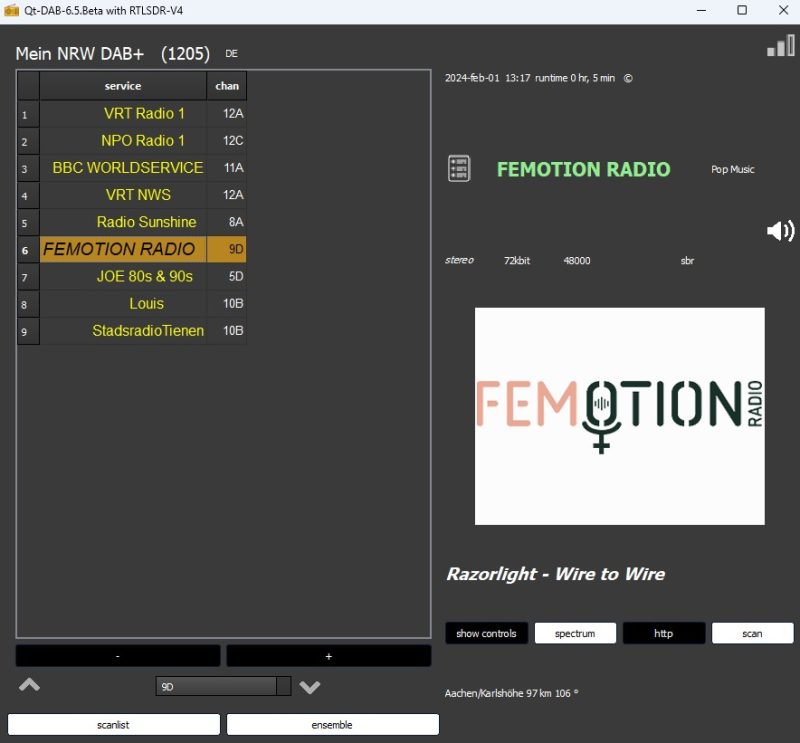
On February 7 2024 I got my new toy: an RSPdx.
As I already owned an RTL-SDRV4 and an RSP1A I wondered how this RSPdx would perform on DAB compared to the trusted RTL-SDRV4 and the RSP1A.
I also own an RTL-SDRV3. On DAB V3 and V4 perform the same in my experience.
Time to do some testing. As the RTL-SDRV4 performs well on DAB vs the other devices, but is outperformed on FM and HF. My AirspyR2 and the RSP1A/RSPdx do a lot better than the RTL-SDR and have of course a wider spectrum to view on OIRT/CCIR/HF. So I decided to concentrate on DAB only.
The SRDplay data sheet tells a few things about the RSPdx performance on DAB.
- Effective blocking of WFM (its “notch” filter), 85-107MHz >50dB attenuation, SW switchable
- Bandwidth ideal for DAB, 1536MHz
- High stability TCXO (0.5ppm)
- For the other bands, a DAB notch filter between 155-235MHz, blocking DAB effectively (>20/30dB)
- A number of bandpass filters, covering also the DAB range (120-250MHz)
What was the set-up for this test?
An antenna splitter fed antennas to the RSPdx to my desktop pc and to the RSP1A to my laptop. (Schematics).
Cables and devices were switched between the desktop and laptop, but that didn’t make a difference at all. The software I used for both devices and on both computers was QIRX 4.2.1.
Qt-DAB would also have been an option, but I didn’t want this test to become too cluttered and unnecessarily complicated.
How was the test run?
A first run was between RSPdx and RTL-SDRV4. Each tested MUX was run simultaneously and logged on both computers for the same time period and the average CNR (dB) and MER (dB) values were calculated.
A second run was between RSPdx and RSP1A with the same procedure. I noticed that a visual and simultaneous short comparison also produced the same values.
I did not check for audio drop-outs as this might a bit tricky to register on two computers at the same time.
Results?
- Comparing CNR (dB) between RSPdx and RTL-SDRV4.
Values for RTL-SDRV4 are slightly higher: on average a mere 0.2 dB. - Comparing MER (dB) between RSPdx and RTL-SDRV4.
Values for RTL-SDRV4 are slightly higher: on average a mere 0.4 dB. - Comparing CNR (dB) between RSPdx and RSP1A.
Values for RSP1A are slightly higher: on average a mere 0.5 dB. - Comparing MER (dB) between RSPdx and RSP1A.
Values for RSP1A are slightly higher: on average a mere 0.2 dB.
As can be concluded from these numbers the differences between all three devices in CNR and MER are almost nil. In only a few instances RTL-SDRV4 or RSP1A detected data where RSPdx didn’t … initially.
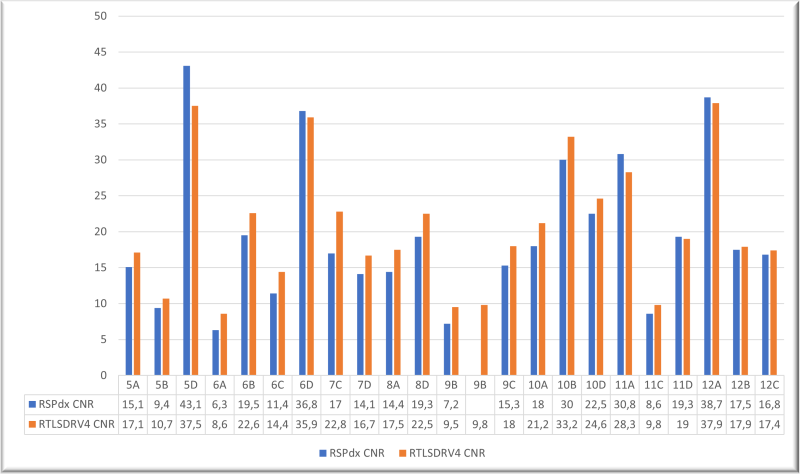
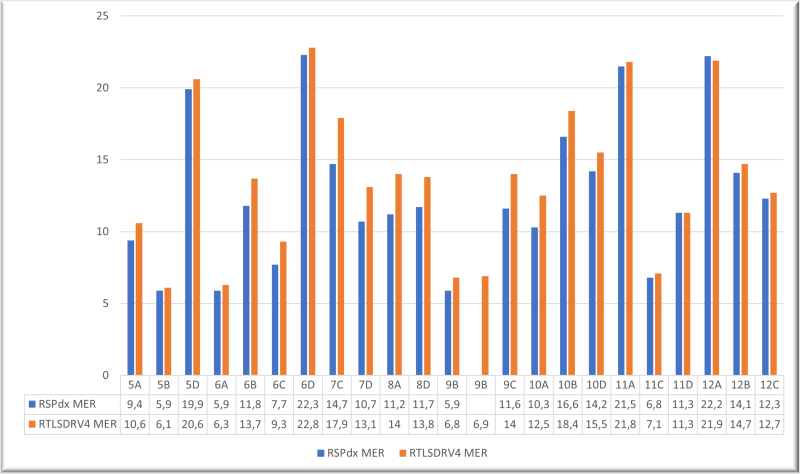
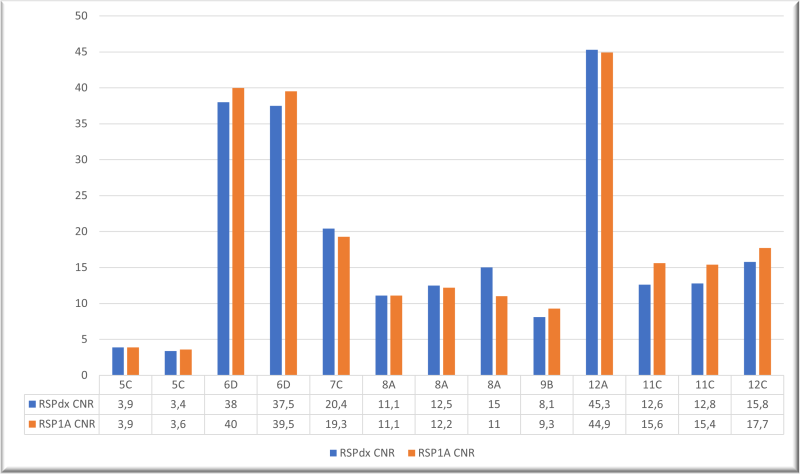
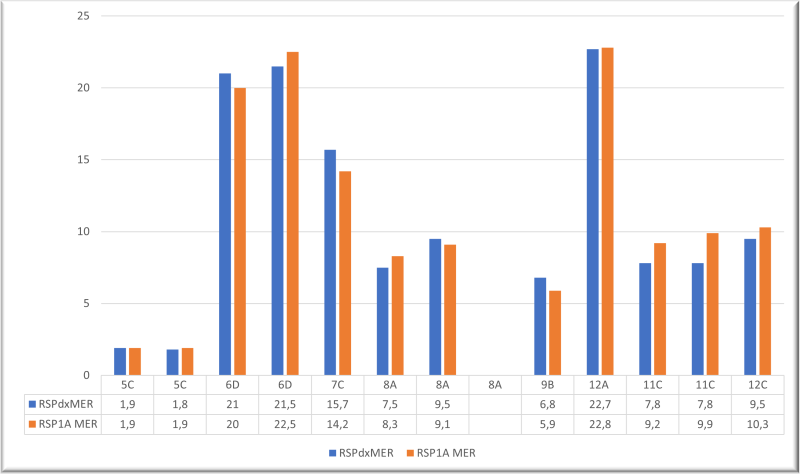
Evaluation
1. RTL-SDRV4
- The RTL-SDRV4 is a relatively cheap device costing about 60 euros. Do mind that the first batch of the RL-SDRV4 had a non-functioning HW AGC. Do check out this page on RTL-SDRV4 drivers.
- As can be seen in the numbers crunched above the RTL-SDRV4 performs excellently on DAB.
If you are only interested in DAB, this device will not disappoint you. - However if you are also into FMDX (small spectrum width) and HF RTL-SDRV4 should be considered to be of entry level. The WRTH 2024 has an informative article on ‘SDR for Beginners: RTL-SDR’ by Oliver Schmidt .
- Setting up this device in QIRX is pretty easy.
Make sure the Bandwidth (frontend, tab R828D) is set to 1.540 kHz or even up to 1.700 kHz.
AGC is on, but of course you can manually set the Gain. The AGC Selector currently has to be set to SW, due to a HW bug.
Don’t forget to activate the Bias-T when using a LNA like the RTL-SDR Blog T.
You only need to do this once as QIRX will remember the settings.
Tip: when considering to buy a RTL-SDRV4 you might want to spend a bit more and purchase the set with dipole antenna kit, which comes in handy when doing some DX on the move.
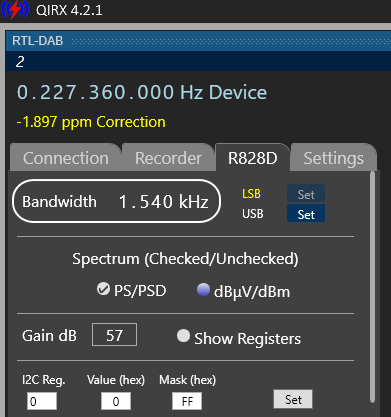
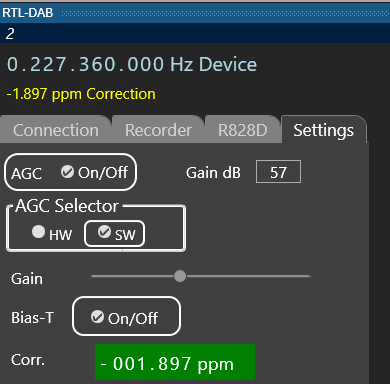
2. RSP1A
- RPS1A is a great device and it performs well not only on DAB, but also on FM an HF.
You can buy an RSP1A device for about 125 euros. - Performance on DAB is excellent, almost of the same level as a RTL-SDRV4 as shown in the test results.
- Setting up RSP1A needs some attention. The user can block DAB and WFM but this setting is not retained for the next session. Surely this will be adjusted in a future QIRX update.
The spectrum width can be set up to a nice about 8 MHz (Select 8192000 Sampling Rate in the QIRX Settings, Sampling Rate). However my old laptop tends to crash with these settings.
There is no ‘DX’ advantage in setting a higher sampling rate though.
As with the RTL-SDRV4 the user can set the AGC on or off and this setting is retained.
All RSPs feature an excellent HW-driven AGC, sadly not including the LNA State.
The Bias-T on/off setting is retained too. - Don’t forget to check and adjust the LNA State as this can prevent overload.
- A correct LNA State can improve reception and often makes a difference between a nice signal or nothing at all! While DXing with RSP1A the user will need to do some fiddling with LNA State settings.
- At the time of writing SDRPlay released its RSP1B, which is not yet supported by QIRX, but with very similar specs as RSP1A. RSP1B comes in a black painted steel case instead of a plastic case (RSP1A
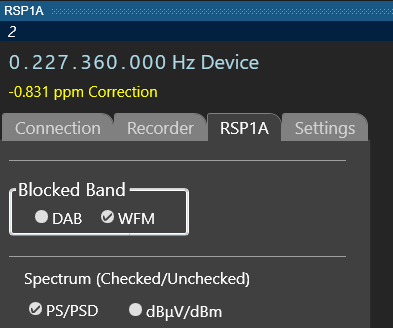
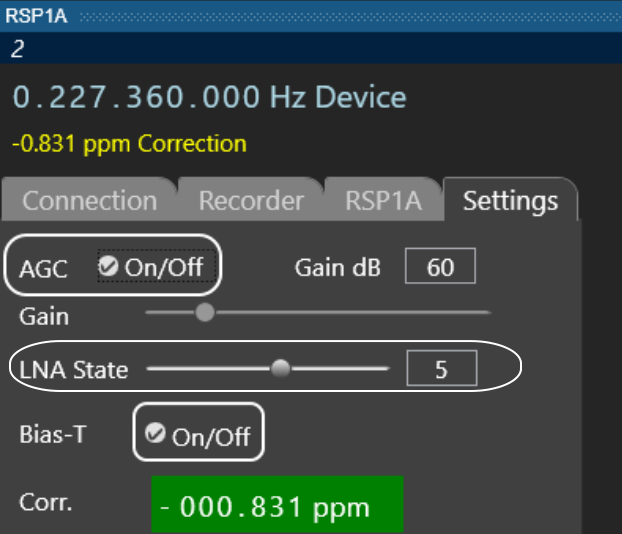
3. RSDdx
- RDSdx is another great device from SDRPlay. As seen above if performs well on DAB. After doing a few tests on FM it seems to me RSDdx is almost on par with AirspyR2. The spectrum width of this device is 10 MHz, the same as AirspyR2. You can purchase an RSPdx for about 240 euros.
- Performance on DAB is excellent as can be seen in the test results.
- The RSPdx has three antenna connections. If you have a LNA connected to your DAB antenna only Antenna B will work as it supports Bias-T.
- Antenna choice and Blocked Band are not retained for the next session, but this might be adjusted in a future QIRX update.
The spectrum width can be set up to a nice about 8 MHz (Select 8192000 Sampling Rate in the QIRX Settings, Sampling Rate). Unfortunately my old laptop tends to crash with these settings.
There is no ‘DX’ advantage in setting a higher sampling rate though. - As with the other devices the gain can be set to either auto (AGC) or manual (slider).
This setting as also the Bias-T is retained. - Adjusting the LNA state is important and it can improve reception a lot.
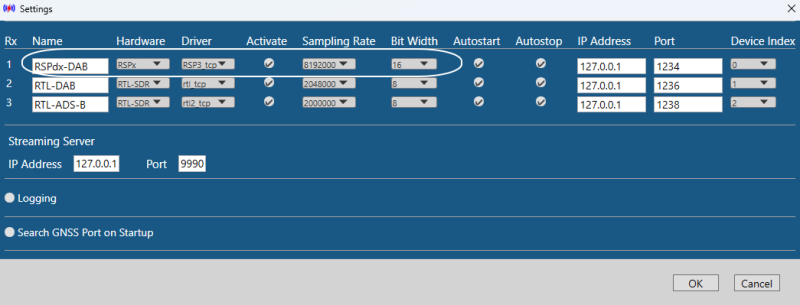
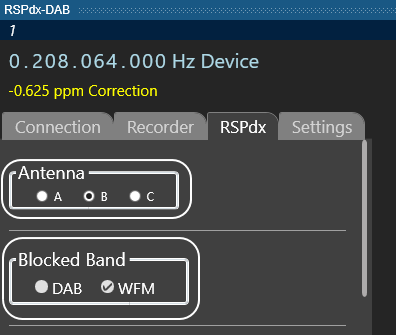
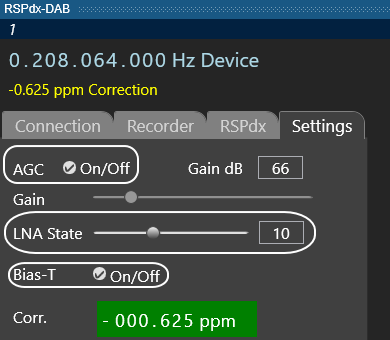
- In the QIRX TII tab Threshold and Average can also be set.
In general it’s best to set the Threshold to Automatic.
Manually setting the threshold level below the noise floor will produce weird and impossible TII values.
Check the TII widget to visualise this. - The TII Average can be set to high for higher sensitivity and low for good realtime response.
As with RSP1A it’s advised to carefully check all the settings especially when there’s DX in the air.
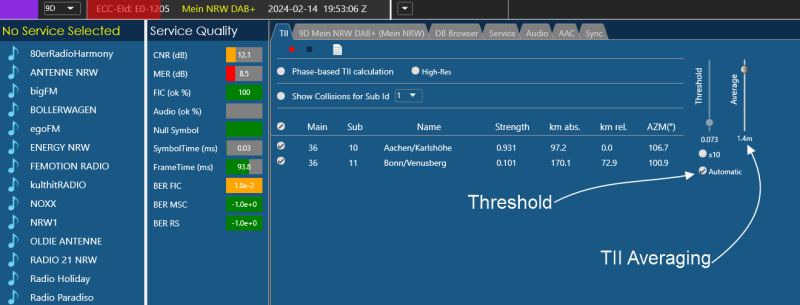
Conclusion
All three devices perform well on DAB. If your only interest is DAB RTL-SDRV4 or RTL-SDRV3 is an excellent choice. If you also want good reception on other bands and don’t mind adjusting a few settings every now and then you should go for an RSP1A or an RSPdx.
Many thanks to Clem Schmidt whose contribution and expertise were invaluable in the creation of this article.
